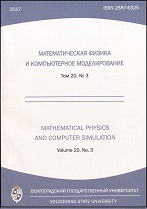|
This article is cited in 1 scientific paper (total in 1 paper)
Physics and astronomy
Heat capacity and defects of vanadium trioxide lattice
Vad. I. Surikov, Val. I. Surikov, S. V. Danilov, V. A. Egorova, N. G. Eysmont, N. A. Semenyuk
Omsk State Technical University
Abstract:
We report the results of studying the heat capacity of samples V$_{2}$O$_{3}$, V$_{2}$O$_{3,04}$, of the region of homogeneity of vanadium trioxide in the temperature range $5$-$250$ K. The samples obtained by reduction of vanadium pentoxide in an atmosphere of purified hydrogen at different temperatures are certified by X-ray phase analysis which showed their singlephase nature. The oxygen content in the samples iss determined by the profits of weight at oxidation to the source vanadium pentoxide, as well as by means of the scanning electron microscope JEOL JCM-5700. The temperature dependence of the heat capacity is analyzed using an automated vacuum adiabatic calorimeter with an accuracy of $\sim 1 \%$. Analysis of the results obtained in the region of helium temperatures allows to represent the temperature dependence of the heat capacity as a sum of two terms, one of which corresponds to the heat capacity of the crystal lattice (the Debye T3 law), and the second exponential term is interpreted as the heat capacity of crystal lattice defects. Mathematical processing of the results allows to estimate some parameters of these compounds, in particular of the Debye temperature, excitation energy and concentration of defects in the crystal lattice of the synthesized samples. The conclusion is made about the increase of defect concentration with increasing oxygen content in the samples, which leads to changes in the phonon spectrum, which is expressed in particular in a significant change of Debye temperature.
Keywords:
heat capacity, vanadium trioxide, metal-insulator phase transition, lattice defects, concentration of defects, Debye temperature.
Citation:
Vad. I. Surikov, Val. I. Surikov, S. V. Danilov, V. A. Egorova, N. G. Eysmont, N. A. Semenyuk, “Heat capacity and defects of vanadium trioxide lattice”, Mathematical Physics and Computer Simulation, 20:6 (2017), 83–88
Linking options:
https://www.mathnet.ru/eng/vvgum217 https://www.mathnet.ru/eng/vvgum/v20/i6/p83
|

|




 Contact us:
Contact us: Terms of Use
Terms of Use
 Registration to the website
Registration to the website Logotypes
Logotypes







 Citation in format
Citation in format 
